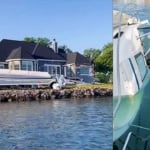So, you’ve spent the summer enjoying your boat, soaking up the sun, and making unforgettable memories on the water. But now that winter is approaching, you’re faced with the important task of properly winterizing your boat. Winterizing your boat is crucial to protect it from the harsh elements and ensure it’s in top shape when the next boating season rolls around. In this article, we’ll discuss the essential measures that should be taken to properly winterize your boat, safeguarding it from potential damage and costly repairs.
Check and Clean
Exterior surfaces
Before winterizing your boat, it’s important to thoroughly check and clean the exterior surfaces. This includes removing any debris such as leaves, branches, or dirt that may have accumulated on the boat. You can use a soft bristle brush and a gentle detergent to scrub away any dirt or grime. Be sure to pay attention to all areas, including the hull, deck, and topside. Once the boat is clean, rinse it thoroughly with fresh water to remove any remaining soap residue.
Interior compartments
After cleaning the exterior surfaces, it’s time to focus on the interior compartments of your boat. Start by emptying out all storage areas and removing any personal items. This is also a good opportunity to declutter and organize your boat’s storage compartments. Once everything is removed, wipe down the interior surfaces with a damp cloth to remove any dust or dirt. Don’t forget to clean out the bilge area as well, removing any water or debris that may have accumulated.
Fuel system
To properly winterize your boat, it’s crucial to take care of the fuel system. Start by adding a fuel stabilizer to the fuel tank. This will help prevent the fuel from deteriorating and causing damage to your engine during the winter months. After adding the stabilizer, run the engine for a few minutes to ensure that the treated fuel circulates throughout the system. Finally, it’s important to drain any remaining fuel from the system to prevent it from causing problems when you start up the boat in the spring.
Water system
Another important aspect of winterizing your boat is taking care of the water system. Start by draining the water tank and all water lines to prevent freezing and potential damage. If your boat has a hot water heater, make sure to drain and bypass it as well. It’s also a good idea to use antifreeze specifically made for marine use to protect any remaining water in the system. This will prevent freezing and potential damage to your boat’s plumbing.
Stabilize Fuel
Adding fuel stabilizer
One of the first steps in stabilizing your boat’s fuel system is adding a fuel stabilizer to the fuel tank. This product is designed to prevent the fuel from deteriorating and causing problems during the winter months. Simply follow the instructions on the bottle to determine the correct amount of stabilizer to add based on the size of your fuel tank. It’s important to use a high-quality stabilizer specifically formulated for marine engines to ensure optimal performance.
Running the engine
After adding the fuel stabilizer, it’s important to run the engine for a few minutes to allow the treated fuel to circulate throughout the system. This will help ensure that all components of the fuel system are protected. It’s also a good opportunity to check for any signs of trouble such as strange noises or vibrations. If you notice any issues, it’s best to address them before storing your boat for the winter.
Draining the fuel system
Once you’ve added the stabilizer and run the engine, it’s time to drain any remaining fuel from the system. This step is essential to prevent old fuel from causing problems when you start up your boat again in the spring. To do this, locate the fuel drain on your boat’s engine and attach a hose to it. Place the other end of the hose in a fuel-safe container and open the drain valve. Allow all the fuel to drain out completely. Once the fuel system is drained, close the drain valve securely.
Change Engine Oil
Draining the old oil
Changing the engine oil before winterizing your boat is crucial for maintaining optimal engine performance. Start by placing an oil pan under the engine and removing the oil drain plug. Allow the old oil to drain completely. Once all the oil has been drained, replace the drain plug securely.
Replacing the oil filter
While you’re changing the oil, it’s also a good idea to replace the oil filter. The oil filter helps remove any impurities and contaminants that can accumulate in the oil over time. To replace the oil filter, locate it on the engine and use an oil filter wrench to loosen and remove it. Be sure to have a drip pan underneath to catch any oil that may spill. Once the old filter is removed, apply a thin layer of fresh oil to the gasket of the new filter before installing it. Finally, tighten the new filter securely by hand.
Adding new oil
After draining the old oil and replacing the oil filter, it’s time to add fresh oil to your boat’s engine. Refer to your boat’s owner’s manual to determine the type and amount of oil required for your specific engine. Use a funnel to pour the new oil into the oil fill cap. Be careful not to overfill the engine, as this can cause damage. Once the proper amount of oil has been added, replace the oil fill cap securely. It’s recommended to run the engine for a few minutes to allow the new oil to circulate throughout the system before storing your boat for the winter.
Prepare the Engine
Fogging the engine
Fogging the engine is an important step in preparing it for winter storage. Fogging oil is used to coat the internal components of the engine, protecting them from corrosion during the off-season. To fog the engine, start by removing the spark plugs. Then, using a fogging oil spray, spray a small amount into each spark plug hole. Slowly turn the engine over a few times to distribute the oil throughout the cylinders. This will ensure that all internal components are protected.
Removing spark plugs
Before completing the fogging process, it’s necessary to remove the spark plugs from the engine. This allows the fogging oil to effectively reach all areas of the combustion chamber. Using a spark plug wrench, carefully loosen and remove each spark plug. Inspect them for any signs of damage or wear. If necessary, clean or replace the spark plugs before reinstalling them in the spring.
Testing the cooling system
To ensure that your boat’s engine cooling system is functioning properly, it’s a good idea to test it before winterizing your boat. Start by checking the coolant level in the reservoir. If it’s low, add the appropriate amount of coolant as recommended by your boat’s manufacturer. Next, start the engine and let it run for a few minutes. Monitor the temperature gauge to ensure that the engine doesn’t overheat. If you notice any abnormal temperature readings or signs of a coolant leak, it’s best to address the issue before storing your boat for the winter.
Protect the Engine Cooling System
Checking and flushing the coolant
Properly maintaining your boat’s engine cooling system is essential for preventing overheating and potential engine damage. Before winterizing your boat, start by checking the coolant level in the reservoir. If it’s low, add the appropriate amount of coolant as recommended by your boat’s manufacturer. Additionally, inspect the coolant for any signs of contamination or discoloration. If the coolant appears dirty or discolored, it’s a good idea to flush the system before adding fresh coolant. Flushing the system will help remove any built-up debris or contaminants.
Replacing the antifreeze
To protect your boat’s engine cooling system from freezing temperatures during the winter, it’s important to replace the antifreeze. Drain the existing coolant from the system, following your boat’s manufacturer guidelines. Once the system is drained, replace it with a marine-specific antifreeze. Be sure to use the correct type and follow the recommended mixing ratio indicated on the antifreeze container. This will ensure that the cooling system is adequately protected from freezing temperatures.
Checking the water pump
The water pump is a vital component of your boat’s cooling system, so it’s important to check it before winterizing your boat. Start by visually inspecting the water pump for any signs of leaking or damage. Additionally, check the pump’s impeller, which is responsible for circulating the coolant. Ensure that the impeller is in good condition and free of any debris that may hinder its performance. If you notice any issues with the water pump, it’s best to have it inspected and repaired by a professional before storing your boat for the winter.
Winterize the Batteries
Cleaning the battery terminals
Properly maintaining your boat’s batteries is essential for their longevity and performance. Before winterizing your boat, start by cleaning the battery terminals. Use a wire brush or battery terminal cleaner to remove any corrosion or build-up on the terminals. It’s important to ensure that the terminals are clean and free of any debris to maintain a solid electrical connection. After cleaning the terminals, apply a thin layer of petroleum jelly or a battery terminal protectant to help prevent future corrosion.
Disconnecting the batteries
To prevent your boat’s batteries from draining and potentially freezing during the winter, it’s important to disconnect them. Start by turning off all electrical devices and systems on your boat. Then, carefully disconnect the battery cables from the terminals. It’s recommended to disconnect the negative cable first, followed by the positive cable. Once the cables are disconnected, secure them away from the terminals to prevent accidental contact. This will help prolong the life of your boat’s batteries and prevent any potential damage.
Storing in a cool, dry place
After disconnecting the batteries, it’s important to store them in a cool, dry place for the winter. Extreme temperatures can cause damage to your boat’s batteries, so it’s best to find a location where the temperature remains relatively stable. It’s also a good idea to place a battery maintainer or charger near the batteries to ensure they remain charged throughout the winter. This will help prevent any potential damage and ensure that the batteries are ready for use when you’re ready to hit the water again in the spring.
Protect the Propellers
Inspecting for damage
Before winterizing your boat, it’s important to inspect the propellers for any signs of damage. Carefully inspect each propeller blade for chips, cracks, or any other issues that may affect its performance. A damaged propeller can lead to decreased efficiency and potential damage to your boat’s engine. If you notice any damage, it’s best to have the propellers inspected and repaired by a professional before storing your boat for the winter.
Cleaning and lubricating
To keep your boat’s propellers in optimal condition, it’s important to clean and lubricate them before winter storage. Start by removing any debris or growth that may have accumulated on the propellers. You can use a soft brush or a specialized propeller cleaner to remove any dirt or marine growth. Once the propellers are clean, apply a marine-grade lubricant or anti-seize compound to the propeller shaft. This will help protect the propellers from corrosion and ensure smooth operation when you’re ready to use your boat again.
Installing propeller covers
To provide additional protection for your boat’s propellers during the winter months, it’s a good idea to install propeller covers. Propeller covers help prevent damage from debris, harsh weather conditions, and any accidental contact. Simply place the covers over the propellers and secure them in place. This will help prolong the life of your propellers and ensure that they’re in good condition when you’re ready to use your boat again in the spring.
Cover and Secure the Boat
Cleaning the boat
Before covering and securing your boat for winter storage, it’s important to give it a thorough cleaning. This includes cleaning the hull, deck, and topside. Use a soft bristle brush and a gentle detergent to scrub away any dirt, grime, or salt residue that may have accumulated. Pay special attention to hard-to-reach areas and crevices. Once the boat is clean, rinse it thoroughly with fresh water to remove any remaining soap residue. This will help protect your boat’s surfaces and minimize the risk of damage during storage.
Removing and storing electronics
To protect your boat’s electronics from potential damage during the winter months, it’s important to remove and store them properly. Start by disconnecting all electrical connections and carefully removing any electronics from their mounting locations. It’s best to store electronics in a cool, dry place away from extreme temperatures and moisture. If possible, wrap them in a soft cloth or bubble wrap to provide additional protection. It’s also a good idea to label and organize the cables and connections to make reinstallation easier in the spring.
Adding a boat cover and straps
After cleaning and removing any electronics, it’s time to cover and secure your boat for the winter. A boat cover will help protect your boat from the elements, UV damage, and potential pests during storage. It’s important to choose a cover specifically designed for your boat’s size and shape. Ensure that the cover fits snugly and is securely fastened with straps or bungee cords. This will help prevent moisture, debris, or animals from entering the boat and causing damage. It’s also a good idea to periodically check the cover throughout the winter to ensure that it remains secure and in good condition.





